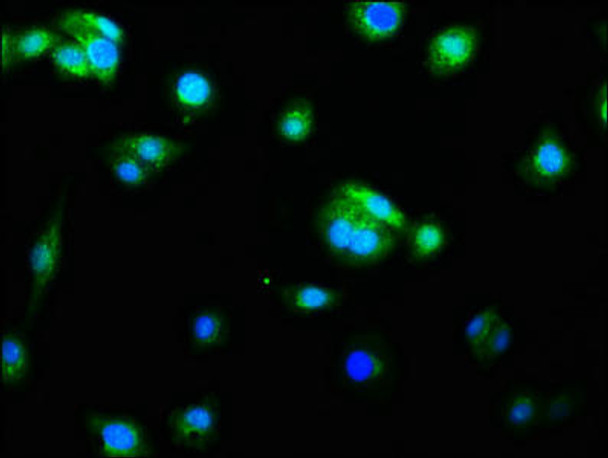Anti-CASP9 Antibody (RACO0158)
- SKU:
- RACO0158
- Product type:
- Recombinant Antibody
- Reactivity:
- Human
- Host Species:
- Human
- Isotype:
- IgG
- Application:
- WB
- Application:
- IF
- Application:
- ELISA
- Application:
- FC
- Conjugation:
- Unconjugated
Frequently bought together:
Description
| 商品名: | CASP9 Antibody |
| Product SKU: | RACO0158 |
| サイズ: | 50ul |
| 宿主種: | Human |
| 申し込み: | ELISA, WB, IF, FC |
| 推奨される希釈: | WB:1:500-1:5000, IF:1:20-1:200 |
| 反応性: | Human |
| 免疫原: | A synthesized peptide derived from human CASP9 |
| 憲法: | Liquid |
| ストレージバッファ: | Rabbit IgG in phosphate buffered saline , pH 7.4, 150mM NaCl, 0.02% sodium azide and 50% glycerol. |
| 精製方法: | Affinity-chromatography |
| 抗体のクローン性: | Monoclonal |
| アイソタイプ: | Rabbit IgG |
| Conjugate: | Non-conjugated |
| バックグラウンド: | Involved in the activation cascade of caspases responsible for apoptosis execution. Binding of caspase-9 to Apaf-1 leads to activation of the protease which then cleaves and activates caspase-3. Promotes DNA damage-induced apoptosis in a ABL1/c-Abl-dependent manner. Proteolytically cleaves poly(ADP-ribose) polymerase (PARP). |
| シノニム: | Caspase-9, Apoptotic protease Mch-6, Apoptotic protease-activating factor 3, APAF-3, ICE-like apoptotic protease 6, ICE-LAP6, Caspase-9 subunit p35, Caspase-9 subunit p10, CASP9, MCH6 |
 | Immunofluorescence staining of HepG2 cells with RACO0158 at 1:60, counter-stained with DAPI. The cells were fixed in 4% formaldehyde, permeabilized using 0.2% Triton X-100 and blocked in 10% normal Goat Serum. The cells were then incubated with the antibody overnight at 4°C. The secondary antibody was Alexa Fluor 488-congugated AffiniPure Goat Anti-Rabbit IgG (H+L). |
 | Overlay histogram showing K562 cells stained with RACO0158 (red line) at 1:50. The cells were fixed with 70% Ethylalcohol (18h) and then permeabilized with 0.3% Triton X-100 for 2 min. The cells were then incubated in 1x PBS /10% normal goat serum to block non-specific protein-protein interactions followed by primary antibody for 1 h at 4°C. The secondary antibody used was FITC goat anti-rabbit IgG (H+L) at 1/200 dilution for 1 h at 4°C. Control antibody (green line) was used under the same conditions. Acquisition of >10,000 events was performed. |
 | Western Blot. Positive WB detected in HL-60 whole cell lysate LO2 whole cell lysate All lanes CASP9 antibody at 1.8µg/ml. Secondary. Goat polyclonal to rabbit IgG at 1:50000 dilution. Predicted band size: 47, 31, 18, 37 KDa. Observed band size: 47 KDa. |
| UniProt Protein Function: | CASP9: a member of the cysteine-aspartic acid protease (caspase) family. Sequential activation of caspases plays a central role in the execution-phase of cell apoptosis. Caspases exist as inactive proenzymes which undergo proteolytic processing at conserved aspartic residues to produce 2 subunits, large and small, that dimerize to form the active enzyme. This protein is processed by caspase APAF1; this step is thought to be one of the earliest in the caspase activation cascade. Alternative splicing results in two isoforms. |
| UniProt Protein Details: | Protein type:Apoptosis; EC 3.4.22.62; Protease Chromosomal Location of Human Ortholog: 1p36.21 Cellular Component: apoptosome; cytosol Molecular Function:cysteine-type endopeptidase activity; enzyme activator activity; peptidase activity; protein binding; protein kinase binding; SH3 domain binding Biological Process: apoptosis; caspase activation via cytochrome c; DNA damage response, signal transduction; DNA damage response, signal transduction resulting in induction of apoptosis; platelet formation; response to DNA damage stimulus |
| NCBI Summary: | This gene encodes a member of the cysteine-aspartic acid protease (caspase) family. Sequential activation of caspases plays a central role in the execution-phase of cell apoptosis. Caspases exist as inactive proenzymes which undergo proteolytic processing at conserved aspartic residues to produce two subunits, large and small, that dimerize to form the active enzyme. This protein can undergo autoproteolytic processing and activation by the apoptosome, a protein complex of cytochrome c and the apoptotic peptidase activating factor 1; this step is thought to be one of the earliest in the caspase activation cascade. This protein is thought to play a central role in apoptosis and to be a tumor suppressor. Alternative splicing results in multiple transcript variants. [provided by RefSeq, May 2013] |
| UniProt Code: | P55211 |
| NCBI GenInfo Identifier: | 28558771 |
| NCBI Gene ID: | 842 |
| NCBI Accession: | P55211.3 |
| UniProt Secondary Accession: | P55211,O95348, Q53Y70, Q5JRU9, Q5UGI1, Q92852, Q9BQ62 Q9UEQ3, Q9UIJ8, B4E1A3, |
| UniProt Related Accession: | P55211 |
| Molecular Weight: | |
| NCBI Full Name: | Caspase-9 |
| NCBI Synonym Full Names: | caspase 9 |
| NCBI Official Symbol: | CASP9 |
| NCBI Official Synonym Symbols: | MCH6; APAF3; APAF-3; PPP1R56; ICE-LAP6 |
| NCBI Protein Information: | caspase-9 |
| UniProt Protein Name: | Caspase-9 |
| UniProt Synonym Protein Names: | Apoptotic protease Mch-6; Apoptotic protease-activating factor 3; APAF-3 |
| Protein Family: | Caspase |
| UniProt Gene Name: | CASP9 |

